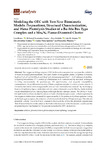Mostrar o rexistro simple do ítem
Modeling the OEC with two new biomimetic models: preparations, structural characterization, and water photolysis studies of a Ba–Mn box type complex and a Mn4N6 planar-diamond cluster
| dc.contributor.author | Rouco, Lara | |
| dc.contributor.author | Fernández-García, M. Isabel | |
| dc.contributor.author | Pedrido, Rosa | |
| dc.contributor.author | Botana, Luis M. | |
| dc.contributor.author | Esteban-Gómez, David | |
| dc.contributor.author | Platas-Iglesias, Carlos | |
| dc.contributor.author | Maneiro, Marcelino | |
| dc.date.accessioned | 2018-09-28T11:25:00Z | |
| dc.date.available | 2018-09-28T11:25:00Z | |
| dc.date.issued | 2018-09-07 | |
| dc.identifier.citation | Rouco, L.; Fernández-García, M.I.; Pedrido, R.; Botana, L.M.; Esteban-Gómez, D.; Platas-Iglesias, C.; Maneiro, M. Modeling the OEC with Two New Biomimetic Models: Preparations, Structural Characterization, and Water Photolysis Studies of a Ba–Mn Box Type Complex and a Mn4N6 Planar-Diamond Cluster. Catalysts 2018, 8, 382. | es_ES |
| dc.identifier.issn | 2073-4344 | |
| dc.identifier.uri | http://hdl.handle.net/2183/21084 | |
| dc.description.abstract | [Abstract] The oxygen-evolving complex (OEC) is the native enzyme that catalyzes the oxidation of water in natural photosynthesis. Two new classes of manganese cluster complexes of formula Ba2Mn2L12(H3L1)2(CH3OH)4 1 and Mn4L26Cl2 2 were prepared (H4L1 = N,N′-(ethane-1,2-diyl)bis(2-hydroxybenzamide); L2 = methyl picolinimidate) and characterized by standard techniques including microanalysis, IR spectroscopy, ESI spectrometry, and magnetic susceptibility measurements. X-ray diffraction studies of these complexes revealed (i) a box-type structure for 1 formed by two redox-active manganese(III) ions and two barium(II) ions connected by two bridging bisamido-bisphenoxy ligand molecules; and (ii) a planar-diamond array for Mn4N6 cluster 2 where the picolinimidates act as chelating ligands through the two nitrogen atoms. The ability of 1 and 2 to split water has been studied by means of water photolysis experiments. In these experiments, the oxygen evolution was measured in aqueous media in the presence of p-benzoquinone (acting as the hydrogen acceptor), the reduction of which was followed by UV-spectroscopy. The relevant photolytic activity found for 1 is in contrast to the inactivity of 2 in the photolytic experiments. This different behavior is discussed on the basis of the structure of the biomimetic models and the proposed reaction mechanism for this process supported by DFT calculations. | es_ES |
| dc.description.sponsorship | Xunta de Galicia; GRC2014/025 | es_ES |
| dc.description.sponsorship | Xunta de Galicia; ED431D 2017/01 | es_ES |
| dc.language.iso | eng | es_ES |
| dc.publisher | MDPI | es_ES |
| dc.relation.uri | https://doi.org/10.3390/catal8090382 | es_ES |
| dc.rights | Atribución 3.0 España | es_ES |
| dc.rights.uri | http://creativecommons.org/licenses/by/3.0/es/ | * |
| dc.subject | Artificial photosynthesis | es_ES |
| dc.subject | Photocatalyst | es_ES |
| dc.subject | Water splitting | es_ES |
| dc.subject | Manganese | es_ES |
| dc.title | Modeling the OEC with two new biomimetic models: preparations, structural characterization, and water photolysis studies of a Ba–Mn box type complex and a Mn4N6 planar-diamond cluster | es_ES |
| dc.type | info:eu-repo/semantics/article | es_ES |
| dc.rights.access | info:eu-repo/semantics/openAccess | es_ES |
| UDC.journalTitle | Catalysts | es_ES |
| UDC.volume | 8 | es_ES |
| UDC.issue | 9 | es_ES |
| UDC.startPage | 382 | es_ES |
Ficheiros no ítem
Este ítem aparece na(s) seguinte(s) colección(s)
-
GI-REACT! - Artigos [107]






